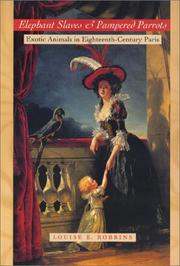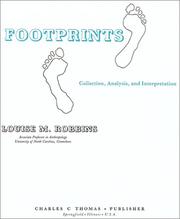| Listing 1 - 10 of 12 | << page >> |
Sort by
|

ISBN: 1280603070 9786610603077 0198028547 1423742001 9780198028543 0195122275 0190284048 Year: 2001 Publisher: New York Oxford University Press
Abstract | Keywords | Export | Availability | Bookmark
 Loading...
Loading...Choose an application
- Reference Manager
- EndNote
- RefWorks (Direct export to RefWorks)
Chronicling Louis Pasteur's rise from humble beginnings to international fame, Louis Pasteur and the Hidden World of Microbes investigates the complex life of a man who revolutionized our understanding of disease. Alongside Pasteur's pioneering work with microorganisms, his innovative use of heat to kill harmful organisms in food--a process now known as "pasteurization"--and his development of the rabies vaccine, Louise Robbins places Pasteur in the context of his risky scientific methods and his rigid family and political beliefs. Robbins's reveals a man of genius with sometimes troubling convictions. Louis Pasteur and the Hidden World of Microbes is a fascinating look at one of the most important scientific minds of the last two centuries.
Scientists --- Microbiologists --- Microbiologists. --- Scientists. --- Professional employees --- Biologists --- Pasteur, Louis, --- Paster, Lui, --- Pa-xtʼ, Lu-i, --- Pasteur, --- פסטר, לואי --- Pasteur, L. --- Pasteur, Luis,

ISBN: 0801867533 Year: 2002 Publisher: Baltimore : Johns Hopkins University Press,
Abstract | Keywords | Export | Availability | Bookmark
 Loading...
Loading...Choose an application
- Reference Manager
- EndNote
- RefWorks (Direct export to RefWorks)
"In 1775 a visitor to Laurent Spinacuta's Grande Menagerie at the annual winter fair in Paris would have seen two tigers, several kinds of monkeys, an armadillo, an ocelot, and a condor - in all, forty-two live animals. In Elephant Slaves and Pampered Parrots, Louise E. Robbins explains that exotic animals from around the world were common in eighteenth-century Paris. In the streets of the city, residents and visitors could observe performing elephants and a fighting polar bear. Those looking for unusual pets could purchase parrots, flying squirrels, and capuchin monkeys. The royal menagerie at Versailles displayed lions, cranes, an elephant, a rhinoceros, and a zebra, which in 1760 became a major court attraction."--BOOK JACKET.
History of civilization --- History of France --- anno 1700-1799 --- Paris --- Wild animals as pets --- Human-animal relationships --- Exotic animals --- Animaux sauvages (Animaux familiers) --- Relations homme-animal --- Animaux exotiques --- History --- History. --- Histoire --- Paris (France) --- Social life and customs --- Moeurs et coutumes --- Native animal pets --- Native animals as pets --- Pet wild animals --- Wild animal pets --- Wild pets --- Wildlife as pets --- Wildlife pets --- Pets --- Wildlife utilization --- Animal-human relationships --- Animal-man relationships --- Animals and humans --- Human beings and animals --- Man-animal relationships --- Relationships, Human-animal --- Animals

ISBN: 080187677X 9780801876776 9780801867538 0801867533 Year: 2002 Publisher: Baltimore Johns Hopkins University Press
Abstract | Keywords | Export | Availability | Bookmark
 Loading...
Loading...Choose an application
- Reference Manager
- EndNote
- RefWorks (Direct export to RefWorks)
"Adds a new dimension to our understanding of eighteenth-century France by investigating the provenance, treatment, and fate of exotic animals living in Paris in the 1700s." -- American Historical Review.
Wild animals as pets --- Human-animal relationships --- Exotic animals --- Animals --- Animal-human relationships --- Animal-man relationships --- Animals and humans --- Human beings and animals --- Man-animal relationships --- Relationships, Human-animal --- Native animal pets --- Native animals as pets --- Pet wild animals --- Wild animal pets --- Wild pets --- Wildlife as pets --- Wildlife pets --- Pets --- Wildlife utilization --- History

ISBN: 0398051380 Year: 1985 Publisher: Springfield, Ill. Thomas
Abstract | Keywords | Export | Availability | Bookmark
 Loading...
Loading...Choose an application
- Reference Manager
- EndNote
- RefWorks (Direct export to RefWorks)
Legal medicine --- Criminology. Victimology --- Criminal law. Criminal procedure
Book
Year: 1991 Publisher: Ann Arbor U.M.I.
Abstract | Keywords | Export | Availability | Bookmark
 Loading...
Loading...Choose an application
- Reference Manager
- EndNote
- RefWorks (Direct export to RefWorks)

ISBN: 0313296448 Year: 1996 Publisher: Westport, Conn. ; London Greenwood Press
Abstract | Keywords | Export | Availability | Bookmark
 Loading...
Loading...Choose an application
- Reference Manager
- EndNote
- RefWorks (Direct export to RefWorks)
Libraries --- Censorship --- United States --- History --- 20th century --- American Library Association --- Libraries - Censorship - United States - History - 20th century.
Book
ISBN: 0299293238 9780299293239 9780299293246 0299293246 Year: 2013 Publisher: Madison, Wisconsin
Abstract | Keywords | Export | Availability | Bookmark
 Loading...
Loading...Choose an application
- Reference Manager
- EndNote
- RefWorks (Direct export to RefWorks)
Books and reading --- Public libraries --- County libraries --- Libraries, County --- Libraries --- History --- 02 "19" --- 027 <73> --- 028 --- 028 Lezen. Lectuur --- Lezen. Lectuur --- 02 "19" Bibliotheekwezen--20e eeuw. Periode 1900-1999 --- Bibliotheekwezen--20e eeuw. Periode 1900-1999 --- 027 <73> Algemene bibliotheken--Verenigde Staten van Amerika. VSA. USA --- Algemene bibliotheken--Verenigde Staten van Amerika. VSA. USA
Book
Year: 1972 Publisher: Ann Arbor University of Michigan press
Abstract | Keywords | Export | Availability | Bookmark
 Loading...
Loading...Choose an application
- Reference Manager
- EndNote
- RefWorks (Direct export to RefWorks)

ISBN: 9780806133140 Year: 2001 Publisher: Norman University of Oklahoma press
Abstract | Keywords | Export | Availability | Bookmark
 Loading...
Loading...Choose an application
- Reference Manager
- EndNote
- RefWorks (Direct export to RefWorks)
In 1950 Ruth W. Brown, librarian at the Bartlesville public library, was dismissed from her job after thirty years of exemplary service, ostensibly because she had circulated subversive materials. In truth, however, Brown was fird because she was active in a group affiliated with the Congress of racial equality. This episode in a small Oklahoma town exemplifies the strange period of the Cold War known as the McCarthy era, foregrounding those who labored for racial justice, sometimes at great cost, before the civil rights movement.
Book
Year: 1972 Publisher: Ann Arbor : University of Michigan, Museum of Anthropology, Publications Department,
Abstract | Keywords | Export | Availability | Bookmark
 Loading...
Loading...Choose an application
- Reference Manager
- EndNote
- RefWorks (Direct export to RefWorks)
| Listing 1 - 10 of 12 | << page >> |
Sort by
|

 Search
Search Feedback
Feedback About UniCat
About UniCat  Help
Help News
News